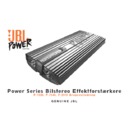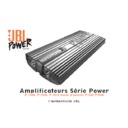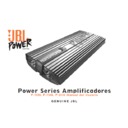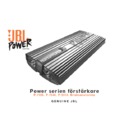JBL P 2510 (serv.man3) User Manual / Operation Manual ▷ View online
5
2. If you are connecting the amplifier to a
factory installed source unit, or to a
source unit that only has speaker level
outputs, connect the speaker outputs
of the source to the speaker inputs on
the amp observing the following color-
code:
Front Left+: White
Front Left-: White with black stripe
Front Right+: Gray
Front Right-: Gray with black stripe
Rear Left+: Green
Rear Left-: Green with black stripe
Rear Right+: Purple
Rear Right-: Purple with black stripe
(Note: When using the Universal
Interface Speaker Level Inputs and
speaker level outputs, the “rem”
terminal on the amplifier may be used
as a remote output connection, and
will provide power to turn on other
amplifiers and processors in the
system.)
(Note: The front and rear inputs on the
P-2510 are summed to mono inside
the amp, and will provide constant
bass regardless of source unit balance
and fader controls)
source unit that only has speaker level
outputs, connect the speaker outputs
of the source to the speaker inputs on
the amp observing the following color-
code:
Front Left+: White
Front Left-: White with black stripe
Front Right+: Gray
Front Right-: Gray with black stripe
Rear Left+: Green
Rear Left-: Green with black stripe
Rear Right+: Purple
Rear Right-: Purple with black stripe
(Note: When using the Universal
Interface Speaker Level Inputs and
speaker level outputs, the “rem”
terminal on the amplifier may be used
as a remote output connection, and
will provide power to turn on other
amplifiers and processors in the
system.)
(Note: The front and rear inputs on the
P-2510 are summed to mono inside
the amp, and will provide constant
bass regardless of source unit balance
and fader controls)
3. If you are connecting your Power
Series amplifier to a source unit with
output voltage higher than 4V, connect
the output signal wires of the source
unit to the Universal Interface Speaker
Inputs. Because the inputs have an
impedance of 10K Ohms, this
connection will provide the best noise-
free performance posssible.
output voltage higher than 4V, connect
the output signal wires of the source
unit to the Universal Interface Speaker
Inputs. Because the inputs have an
impedance of 10K Ohms, this
connection will provide the best noise-
free performance posssible.
4. In some systems it may be desirable
to have two sources play
simultaneously through the audio
system . For instance, if you have a
factory installed radio in your car, and
you want to add an aftermarket CD
player, you may connect the CD player
to the RCA inputs of the amp, and the
factory radio to the Universal Interface
Speaker Inputs. Note: Front and rear
channels of the CD and radio must be
driven into the front and rear inputs of
the amplifier. Use Y adapters if
necessary. The Universal Interface
circuitry will isolate the two signals
from each other while allowing them
to drive the amp simultaneously.
Therefore switching from one source
to the other is as simple as turning the
unused source off, and the other on.
(Note: you must connect the remote
turn-on wire from the CD player to the
Rem terminal on the amp. Install a
diode in the remote line from the CD
player as shown in the diagram
below.)
simultaneously through the audio
system . For instance, if you have a
factory installed radio in your car, and
you want to add an aftermarket CD
player, you may connect the CD player
to the RCA inputs of the amp, and the
factory radio to the Universal Interface
Speaker Inputs. Note: Front and rear
channels of the CD and radio must be
driven into the front and rear inputs of
the amplifier. Use Y adapters if
necessary. The Universal Interface
circuitry will isolate the two signals
from each other while allowing them
to drive the amp simultaneously.
Therefore switching from one source
to the other is as simple as turning the
unused source off, and the other on.
(Note: you must connect the remote
turn-on wire from the CD player to the
Rem terminal on the amp. Install a
diode in the remote line from the CD
player as shown in the diagram
below.)
System Set-Up and Adjustment
Electronic Crossover
The electronic crossover in the P-7520,
P-7540 and P-2510 should be used to
route the appropriate signal to speakers
intended to play only bass, midbass,
midrange or treble frequencies. The
crossover slope is 12dB/oct and the
frequency is variable from 32Hz - 320Hz.
The electronic crossover in the P-7520,
P-7540 and P-2510 should be used to
route the appropriate signal to speakers
intended to play only bass, midbass,
midrange or treble frequencies. The
crossover slope is 12dB/oct and the
frequency is variable from 32Hz - 320Hz.
Pre-amp Outputs
Connect these to the input connectors of
other amplifiers or processors in your
system.
Connect these to the input connectors of
other amplifiers or processors in your
system.
The crossover selector switch determines
which filter will be assigned to the pre-
amp outputs. The pre-amp outputs may
be High Pass (switch set to HP), Low Pass
(switch set to LP), or unfiltered (switch set
to Flat). The crossover frequency is
determined by the crossover frequency
control, and will be the same frequency
as the amplifier channels affected by that
control.
Refer to the “Applications” section for
system expansion possibilities.
which filter will be assigned to the pre-
amp outputs. The pre-amp outputs may
be High Pass (switch set to HP), Low Pass
(switch set to LP), or unfiltered (switch set
to Flat). The crossover frequency is
determined by the crossover frequency
control, and will be the same frequency
as the amplifier channels affected by that
control.
Refer to the “Applications” section for
system expansion possibilities.
Setting Input Sensitivity
Proper input sensitivity control settings
on Power Series amplifiers are critical to
ensure optimum performance, low noise
levels and maximum system reliability.
As a general rule, controls at the front
end of a system (source, equalizers, and
other processors) should be set as high
as possible with the amplifier input
sensitivity set as low as possible while
still providing adequate volume levels.
Using a high signal level and a low
sensitivity setting will help keep
background noise in the system to a
minimum.
Proper input sensitivity control settings
on Power Series amplifiers are critical to
ensure optimum performance, low noise
levels and maximum system reliability.
As a general rule, controls at the front
end of a system (source, equalizers, and
other processors) should be set as high
as possible with the amplifier input
sensitivity set as low as possible while
still providing adequate volume levels.
Using a high signal level and a low
sensitivity setting will help keep
background noise in the system to a
minimum.
Initially, turn the input sensitivity GAIN
control to its minimum (counter-
clockwise) position.
1. Reconnect the (–) negative lead to
control to its minimum (counter-
clockwise) position.
1. Reconnect the (–) negative lead to
your vehicle’s battery. Apply power to
the audio system and play a favorite
music track from CD or tape.
NOTE: After the source unit is on, the
JBL badge (on the top panel) will
illuminate, indicating the amplifier is
on. If not, check the wiring, especially
the remote connection from the
source unit. Also refer to
“Troubleshooting” on the next page.
the audio system and play a favorite
music track from CD or tape.
NOTE: After the source unit is on, the
JBL badge (on the top panel) will
illuminate, indicating the amplifier is
on. If not, check the wiring, especially
the remote connection from the
source unit. Also refer to
“Troubleshooting” on the next page.
2. On the source unit, increase the
volume control until it is
approximately 3/4 of its maximum
output level. Slowly increase the Input
Sensitivity control (clockwise) towards
three o’clock and, at the same time,
listen to the quality of the reproduced
sound. At some point, you’ll hear
distortion on the music peaks. Stop
the adjustment and turn it back
slightly. This is the maximum
undistorted output level of your
system, and should not be exceeded
during use.
approximately 3/4 of its maximum
output level. Slowly increase the Input
Sensitivity control (clockwise) towards
three o’clock and, at the same time,
listen to the quality of the reproduced
sound. At some point, you’ll hear
distortion on the music peaks. Stop
the adjustment and turn it back
slightly. This is the maximum
undistorted output level of your
system, and should not be exceeded
during use.
From
Source
Unit
Source
Unit
To
Amp
Amp
IN4001 Diode
6
7
+R–
+R–
–L+
–L+
AUX
OUT
OUT
R
L
R
L
FRONT
FRONT
REAR
LINE LEVEL
INPUT
SPKR LEVEL IN
REAR
+ R –
+ R –
– L +
– L +
R
L
FRONT
FRONT
REAR
LINE LEVEL
INPUT
UNIVERSAL INTERFACE
REAR
3. After adjusting the level of the main
speakers in your system, you should
adjust the remaining channels (if you
are using a P-7540 or a multi-amp
system) for the desired system
balance. You’ll find this easiest to do
by adjusting the channels in the
following order: 1) front speakers, 2)
rear speakers, 3) subwoofer.
Elaborate, multi-channel systems may
be complex to adjust. Your local JBL
installation specialist is the best
person to help with such adjustment.
adjust the remaining channels (if you
are using a P-7540 or a multi-amp
system) for the desired system
balance. You’ll find this easiest to do
by adjusting the channels in the
following order: 1) front speakers, 2)
rear speakers, 3) subwoofer.
Elaborate, multi-channel systems may
be complex to adjust. Your local JBL
installation specialist is the best
person to help with such adjustment.
Applications
For your convenience, we’ve included
several application diagrams to help you
plan your own system installation.
Figures 1 through 3 show how to
configure the JBL P-7520, P-7540 or
P-2510 for stereo, bridged-mono, and
tri-mode operation.
For system expansion ideas, see Figures
4 and 5.
NOTE: For simplicity, Figures 1 through 3
do not show power, remote, and input
connections.
several application diagrams to help you
plan your own system installation.
Figures 1 through 3 show how to
configure the JBL P-7520, P-7540 or
P-2510 for stereo, bridged-mono, and
tri-mode operation.
For system expansion ideas, see Figures
4 and 5.
NOTE: For simplicity, Figures 1 through 3
do not show power, remote, and input
connections.
30
– R +
– L +
+BATT
REM
GND
FUSE
30A
MADE IN THE U.S.A.
BRIDGE
SPEAKER OUTPUTS
POWER
PRE OUT
LEVEL
INPUT MODE
MO ST
4V
.250V
XOVER
FLAT
HP
LP
FLAT
HP
LP
2V
FREQ
32Hz
320Hz
80Hz
30
– R +
– L +
+BATT
REM
GND
FUSE
30A
MADE IN THE U.S.A.
BRIDGE
SPEAKER OUTPUTS
POWER
PRE OUT
LEVEL
INPUT MODE
MO ST
4V
.250V
XOVER
FLAT
HP
LP
FLAT
HP
LP
2V
FREQ
32Hz
320Hz
80Hz
30
– R +
– L +
+BATT
REM
GND
FUSE
30A
MADE IN THE U.S.A.
BRIDGE
SPEAKER OUTPUTS
POWER
PRE OUT
LEVEL
INPUT MODE
MO ST
4V
.250V
XOVER
FLAT
HP
LP
FLAT
HP
LP
2V
FREQ
32Hz
320Hz
80Hz
Figure 1. This wiring diagram shows a
JBL P-7520/7540 amplifier set to stereo to
drive a pair(s) of full-range speakers.
JBL P-7520/7540 amplifier set to stereo to
drive a pair(s) of full-range speakers.
Figure 2. This wiring diagram shows a
JBL P-7520/7540 amplifier set to bridge
mode (mono) to drive a single subwoofer
or a pair of subwoofers (P-7540).
JBL P-7520/7540 amplifier set to bridge
mode (mono) to drive a single subwoofer
or a pair of subwoofers (P-7540).
Figure 3. This wiring diagram shows a
JBL P-75207540 amplifier set for tri-mode
operation. For a desired crossover
frequency, use the chart on page 4 to
select a inductor for the subwoofer, and
corresponding capacitors for left and
right speakers.
JBL P-75207540 amplifier set for tri-mode
operation. For a desired crossover
frequency, use the chart on page 4 to
select a inductor for the subwoofer, and
corresponding capacitors for left and
right speakers.
Figure 4. In this example system, a JBL
P-7540 drives two pairs of 5 1⁄4" speakers.
The JBL P-7540’s pre-amp outputs feed a
JBL P-2510 to drive a single 12"
subwoofer.
P-7540 drives two pairs of 5 1⁄4" speakers.
The JBL P-7540’s pre-amp outputs feed a
JBL P-2510 to drive a single 12"
subwoofer.
ST MO
INPUT MODE
LEVEL
INPUT
PRE OUT
LEVEL
INPUT MODE
MO ST
MO ST
6V
.250V
4V
.250V
FRONT
F+R
FLAT
REAR
LP
FRT
LP
LP
FRT
REAR
REAR
XOVER
FLAT HP LP
XOVER
FLAT HP
LP
XOVER
AMP
AMP
XOVER
AMP
32Hz
80Hz
320Hz
32Hz
80Hz
2V
2V
320Hz
FUSE
30A
BRIDGE
– R +
– L +
MADE IN THE U.S.A.
+BATT
REM
GND
BRIDGE
SPEAKER OUTPUTS
POWER
FRONT
REAR
30
FUSE
30A
30
40
+ +
– –
MADE IN THE U.S.A.
SPEAKER OUTPUTS
FUSE
40A
+BATT
REM
GND
POWER
Figure 5. In this expanded system, a JBL P-7540
drives two pairs of 5-1/4 “ 2-way speakers. The
JBL P-7540’s pre-amp outputs feed a JBL P-2510
which drives single 12" subwoofer.
drives two pairs of 5-1/4 “ 2-way speakers. The
JBL P-7540’s pre-amp outputs feed a JBL P-2510
which drives single 12" subwoofer.
LEVEL
FREQ
4V
.250V
32Hz
80Hz
320Hz
2V
FUSE
30A
BRIDGE
– R +
– L +
MADE IN THE U.S.A.
+BATT
REM
GND
BRIDGE
SPEAKER OUTPUTS
POWER
FRONT
REAR
30
FUSE
30A
30
ST MO
INPUT MODE
LEVEL
INPUT
PRE OUT
LEVEL
INPUT MODE
MO ST
MO ST
6V
.250V
4V
.250V
FRONT
F+R
FLAT
REAR
LP
FRT
LP
LP
FRT
REAR
REAR
XOVER
FLAT HP LP
XOVER
FLAT HP
LP
XOVER
AMP
AMP
XOVER
AMP
32Hz
80Hz
320Hz
32Hz
80Hz
2V
2V
320Hz
7
Symptom
Likely Cause
Solution
No audio
Low/No Remote On Voltage
Check connections; Test turn-on voltage
Speakers are not connected
Check wiring; use VOM/DVM to
or are blown
measure speaker coil resistance
Distorted audio
Input sensitivity is not set properly
See Setting Input Sensitivity on previous page
Audio lacks “punch”
Speakers are wired with wrong polarity
Check polarity of connections;
refer to Applications
refer to Applications
Audio cycles off and on;
A protection circuit is turning the
Verify the following: electrical system is
Amber protection LED
amplifier off and on
between 5 ~ 18 V dc; temperature is not
(JBL badge on top panel)
over 194°F (90°C); no short circuits; speaker
is flashing
loads are not less than 2 ohm (4 ohms in
mono)
mono)
Audio cycles off and on; Amber
GAIN is set too high
Set Input Sensitivity correctly
protection LED (on top panel)
(see previous page)
is flashing
Fuse blows
Incorrect wiring or short circuit
Check connections; refer to Applications
Many different system configurations are
possible using the crossovers and pre-
amp outputs featured in Power Series
amplifiers. If you are considering
expanding you system beyond what is
shown here, please consult your local JBL
installation specialist who is experienced
in designing complex mobile audio
systems.
possible using the crossovers and pre-
amp outputs featured in Power Series
amplifiers. If you are considering
expanding you system beyond what is
shown here, please consult your local JBL
installation specialist who is experienced
in designing complex mobile audio
systems.
Troubleshooting
Use the following guide to identify
symptoms and solve problems. Make
sure the vehicle’s electrical system is
working properly and power is reaching
the amplifier.
symptoms and solve problems. Make
sure the vehicle’s electrical system is
working properly and power is reaching
the amplifier.
JBL Consumer Products
250 Crossways Park Drive
Woodbury, NY 11797
www.jbl.com
250 Crossways Park Drive
Woodbury, NY 11797
www.jbl.com
Part No. SH1124
Made in DK
Made in DK
Declaration of Conformity
Kongevejen 194B
DK-3460 Birkerød
DENMARK
DK-3460 Birkerød
DENMARK
declare in own responsibility, that the products described
in this owner’s manual are in compliance with technical
standard:
Steen Michaelsen
Birkerød. DENMARK. 7/98
EN 55 013/A12/8. 1994
EN 55 020. 1994
EN 55 020. 1994
Specifications
JBL P-7520
JBL P-7540
JBL P-2510
Power Output, 4 ohms:
2 x 75 watts
4 x 75 watts
1 x 250 watts
Power Output, 2 ohms:
2 x 100 watts
4 x 100 watts
1 x 375 watts
Power Output, Bridged 4 ohms:
200 watts
2 x 200 watts
Frequency Response:
20Hz ~ 20kHz +0dB, –1dB
20Hz ~ 20kHz +0dB, –1dB
20Hz ~ 320Hz +0dB, –1dB
Input Sensitivity:
250mV ~ 4V
250mV ~ 4V
250mV ~ 4V
THD + Noise (4 ohms):
0.05 %
0.05 %
0.1 %
Signal-to-Noise:
>100dB
>100dB
>100dB
Maximum Current Draw:
35A
64A
41A
Dimensions (w x h x l):
13-5/8 x 2-1/4 x 8-3/4 in
21-5/8 x 2-1/4 x 8-3/4 in.
7-5/8 x 2-1/4 x 8-3/4 in.
347 x 58 x 223mm
549 x 58 x 223 mm
194 x 58 x 223 mm
Specifications
P-7520, P-7540, P-2510
Steen Michaelsen
Birkerød. DENMARK 9/98
Display












